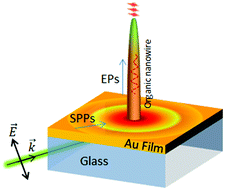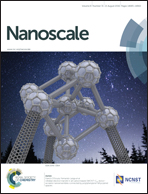Plasmon-controlled excitonic emission from vertically-tapered organic nanowires†
Abstract
Organic molecular nanophotonics has emerged as an important avenue to harness molecular aggregation and crystallization on various functional platforms to obtain nano-optical devices. To this end, there is growing interest to combine organic molecular nanostructures with plasmonic surfaces and interfaces. Motivated by this, herein we introduce a unique geometry: vertically-tapered organic nanowires grown on a plasmonic thin film. A polarization-sensitive plasmon–polariton on a gold thin-film was harnessed to control the exciton–polariton propagation and subsequent photoluminescence from an organic nanowire made of diaminoanthraquinone (DAAQ) molecules. We show that the exciton–polariton emission from individual DAAQ nanowires can be modulated up to a factor of 6 by varying the excitation polarization state of surface plasmons. Our observations were corroborated with full-wave three-dimensional finite-difference time-domain calculations performed on vertically-tapered nanowire geometry. Our work introduces a new optical platform to study coupling between propagating plasmons and propagating excitons, and may have implications in emerging fields such as hybrid-polariton based light emitting devices and vertical-cavity nano-optomechanics.


 Please wait while we load your content...
Please wait while we load your content...